FIAT 500L LIVING 2014 2.G Owners Manual
Manufacturer: FIAT, Model Year: 2014, Model line: 500L LIVING, Model: FIAT 500L LIVING 2014 2.GPages: 420, PDF Size: 9.77 MB
Page 261 of 420
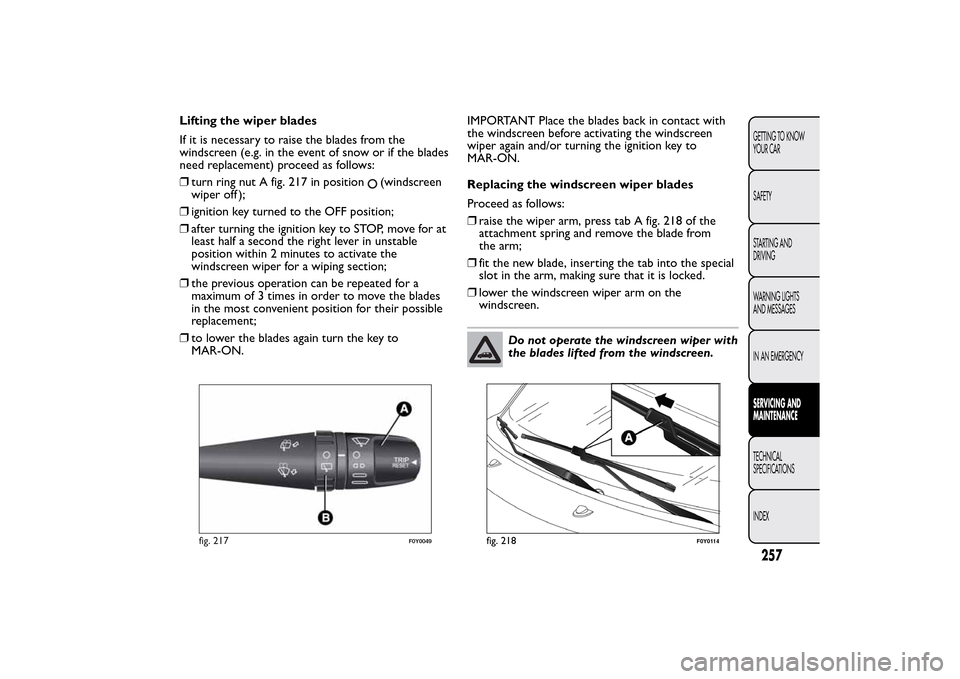
Lifting the wiper blades
If it is necessary to raise the blades from the
windscreen (e.g. in the event of snow or if the blades
need replacement) proceed as follows:
❒turn ring nut A fig. 217 in position
(windscreen
wiper off );
❒ignition key turned to the OFF position;
❒after turning the ignition key to STOP, move for at
least half a second the right lever in unstable
position within 2 minutes to activate the
windscreen wiper for a wiping section;
❒the previous operation can be repeated for a
maximum of 3 times in order to move the blades
in the most convenient position for their possible
replacement;
❒to lower the blades again turn the key to
MAR-ON.IMPORTANT Place the blades back in contact with
the windscreen before activating the windscreen
wiper again and/or turning the ignition key to
MAR-ON.
Replacing the windscreen wiper blades
Proceed as follows:
❒raise the wiper arm, press tab A fig. 218 of the
attachment spring and remove the blade from
the arm;
❒fit the new blade, inserting the tab into the special
slot in the arm, making sure that it is locked.
❒lower the windscreen wiper arm on the
windscreen.
Do not operate the windscreen wiper with
the blades lifted from the windscreen.
fig. 217
F0Y0049
fig. 218
F0Y0114
257GETTING TO KNOW
YOUR CAR
SAFETY
STARTING AND
DRIVING
WARNING LIGHTS
AND MESSAGES
IN AN EMERGENCYSERVICING AND
MAINTENANCETECHNICAL
SPECIFICATIONS
INDEX
Page 262 of 420
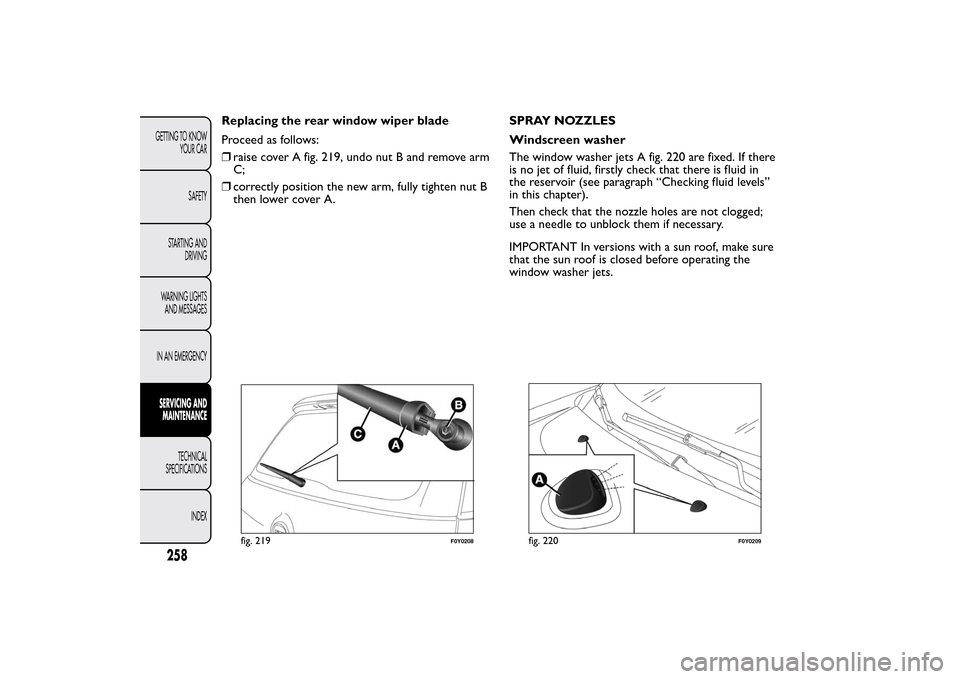
Replacing the rear window wiper blade
Proceed as follows:
❒raise cover A fig. 219, undo nut B and remove arm
C;
❒correctly position the new arm, fully tighten nut B
then lower cover A.SPRAY NOZZLES
Windscreen washer
The window washer jets A fig. 220 are fixed. If there
is no jet of fluid, firstly check that there is fluid in
the reservoir (see paragraph “Checking fluid levels”
in this chapter).
Then check that the nozzle holes are not clogged;
use a needle to unblock them if necessary.
IMPORTANT In versions with a sun roof, make sure
that the sun roof is closed before operating the
window washer jets.
fig. 219
F0Y0208
fig. 220
F0Y0209
258GETTING TO KNOW
YOUR CAR
SAFETY
STARTING AND
DRIVING
WARNING LIGHTS
AND MESSAGES
IN AN EMERGENCYSERVICING AND
MAINTENANCE
TECHNICAL
SPECIFICATIONS
INDEX
Page 263 of 420
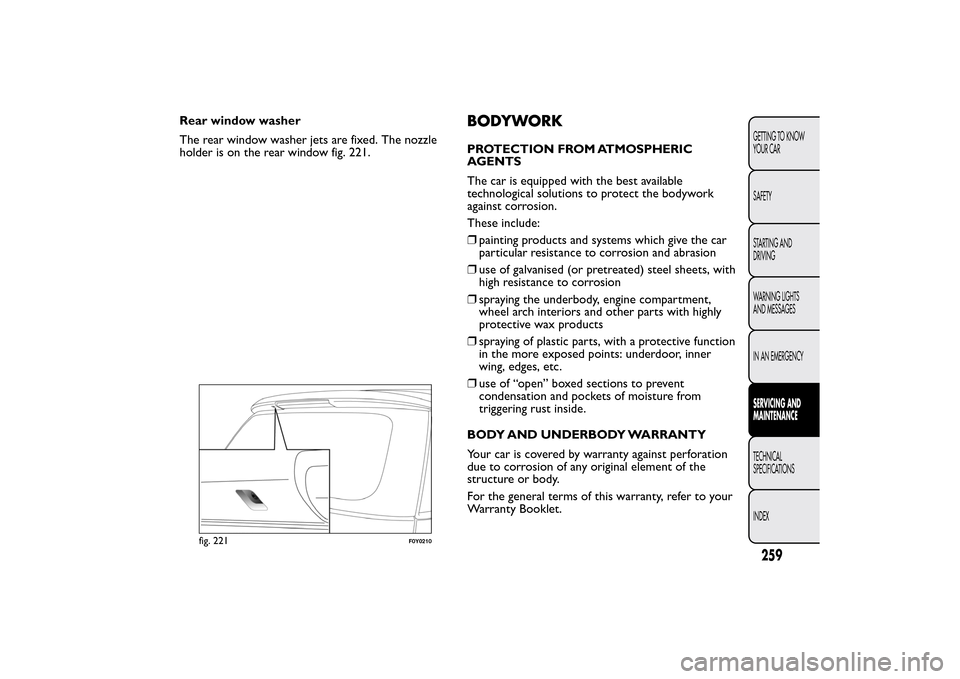
Rear window washer
The rear window washer jets are fixed. The nozzle
holder is on the rear window fig. 221.
BODYWORKPROTECTION FROM ATMOSPHERIC
AGENTS
The car is equipped with the best available
technological solutions to protect the bodywork
against corrosion.
These include:
❒painting products and systems which give the car
particular resistance to corrosion and abrasion
❒use of galvanised (or pretreated) steel sheets, with
high resistance to corrosion
❒spraying the underbody, engine compartment,
wheel arch interiors and other parts with highly
protective wax products
❒spraying of plastic parts, with a protective function
in the more exposed points: underdoor, inner
wing, edges, etc.
❒use of “open” boxed sections to prevent
condensation and pockets of moisture from
triggering rust inside.
BODY AND UNDERBODY WARRANTY
Your car is covered by warranty against perforation
due to corrosion of any original element of the
structure or body.
For the general terms of this warranty, refer to your
Warranty Booklet.
fig. 221
F0Y0210
259GETTING TO KNOW
YOUR CAR
SAFETY
STARTING AND
DRIVING
WARNING LIGHTS
AND MESSAGES
IN AN EMERGENCYSERVICING AND
MAINTENANCETECHNICAL
SPECIFICATIONS
INDEX
Page 264 of 420
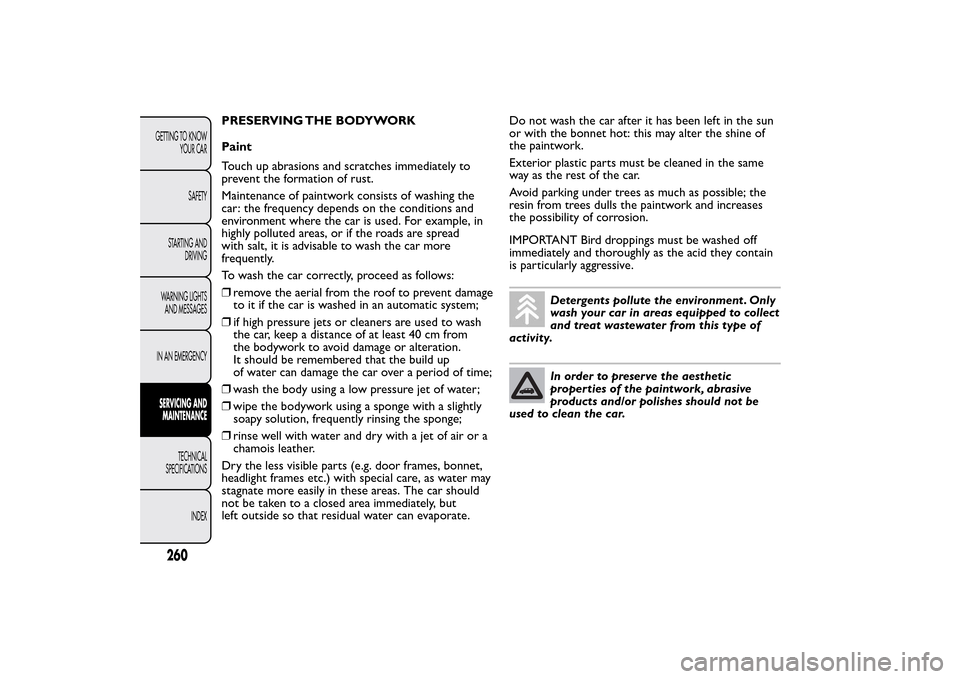
PRESERVING THE BODYWORK
Paint
Touch up abrasions and scratches immediately to
prevent the formation of rust.
Maintenance of paintwork consists of washing the
car: the frequency depends on the conditions and
environment where the car is used. For example, in
highly polluted areas, or if the roads are spread
with salt, it is advisable to wash the car more
frequently.
To wash the car correctly, proceed as follows:
❒remove the aerial from the roof to prevent damage
to it if the car is washed in an automatic system;
❒if high pressure jets or cleaners are used to wash
the car, keep a distance of at least 40 cm from
the bodywork to avoid damage or alteration.
It should be remembered that the build up
of water can damage the car over a period of time;
❒wash the body using a low pressure jet of water;
❒wipe the bodywork using a sponge with a slightly
soapy solution, frequently rinsing the sponge;
❒rinse well with water and dry with a jet of air or a
chamois leather.
Dry the less visible parts (e.g. door frames, bonnet,
headlight frames etc.) with special care, as water may
stagnate more easily in these areas. The car should
not be taken to a closed area immediately, but
left outside so that residual water can evaporate.Do not wash the car after it has been left in the sun
or with the bonnet hot: this may alter the shine of
the paintwork.
Exterior plastic parts must be cleaned in the same
way as the rest of the car.
Avoid parking under trees as much as possible; the
resin from trees dulls the paintwork and increases
the possibility of corrosion.
IMPORTANT Bird droppings must be washed off
immediately and thoroughly as the acid they contain
is particularly aggressive.
Detergents pollute the environment . Only
wash your car in areas equipped to collect
and treat wastewater from this type of
activity.In order to preserve the aesthetic
properties of the paintwork, abrasive
products and/or polishes should not be
used to clean the car.
260GETTING TO KNOW
YOUR CAR
SAFETY
STARTING AND
DRIVING
WARNING LIGHTS
AND MESSAGES
IN AN EMERGENCYSERVICING AND
MAINTENANCE
TECHNICAL
SPECIFICATIONS
INDEX
Page 265 of 420
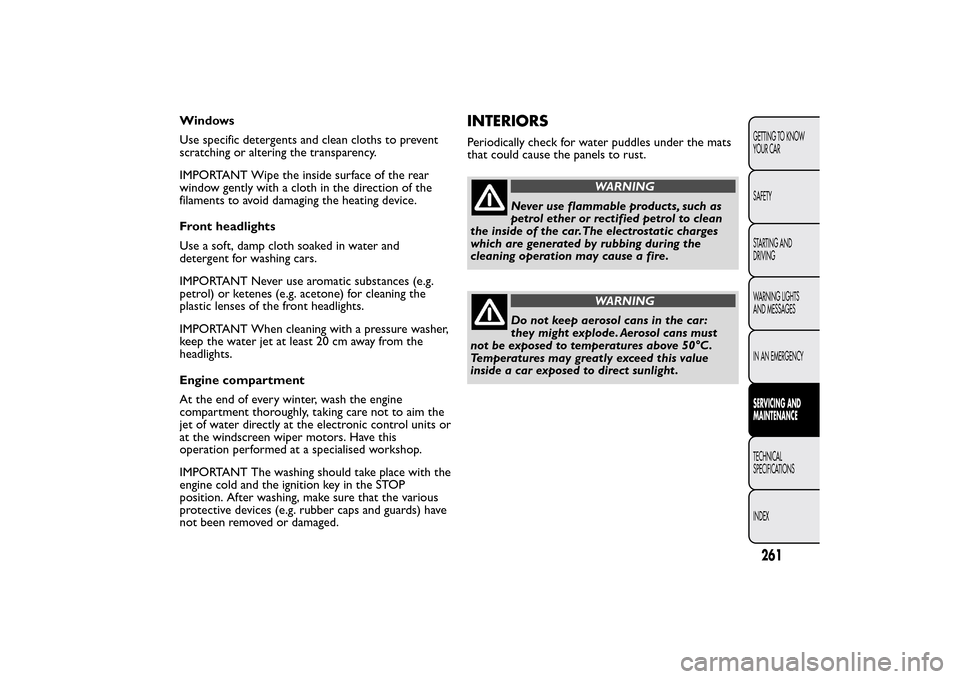
Windows
Use specific detergents and clean cloths to prevent
scratching or altering the transparency.
IMPORTANT Wipe the inside surface of the rear
window gently with a cloth in the direction of the
filaments to avoid damaging the heating device.
Front headlights
Use a soft, damp cloth soaked in water and
detergent for washing cars.
IMPORTANT Never use aromatic substances (e.g.
petrol) or ketenes (e.g. acetone) for cleaning the
plastic lenses of the front headlights.
IMPORTANT When cleaning with a pressure washer,
keep the water jet at least 20 cm away from the
headlights.
Engine compartment
At the end of every winter, wash the engine
compartment thoroughly, taking care not to aim the
jet of water directly at the electronic control units or
at the windscreen wiper motors. Have this
operation performed at a specialised workshop.
IMPORTANT The washing should take place with the
engine cold and the ignition key in the STOP
position. After washing, make sure that the various
protective devices (e.g. rubber caps and guards) have
not been removed or damaged.
INTERIORSPeriodically check for water puddles under the mats
that could cause the panels to rust.
WARNING
Never use flammable products, such as
petrol ether or rectified petrol to clean
the inside of the car.The electrostatic charges
which are generated by rubbing during the
cleaning operation may cause a fire.
WARNING
Do not keep aerosol cans in the car:
they might explode. Aerosol cans must
not be exposed to temperatures above 50°C .
Temperatures may greatly exceed this value
inside a car exposed to direct sunlight .
261GETTING TO KNOW
YOUR CAR
SAFETY
STARTING AND
DRIVING
WARNING LIGHTS
AND MESSAGES
IN AN EMERGENCYSERVICING AND
MAINTENANCETECHNICAL
SPECIFICATIONS
INDEX
Page 266 of 420
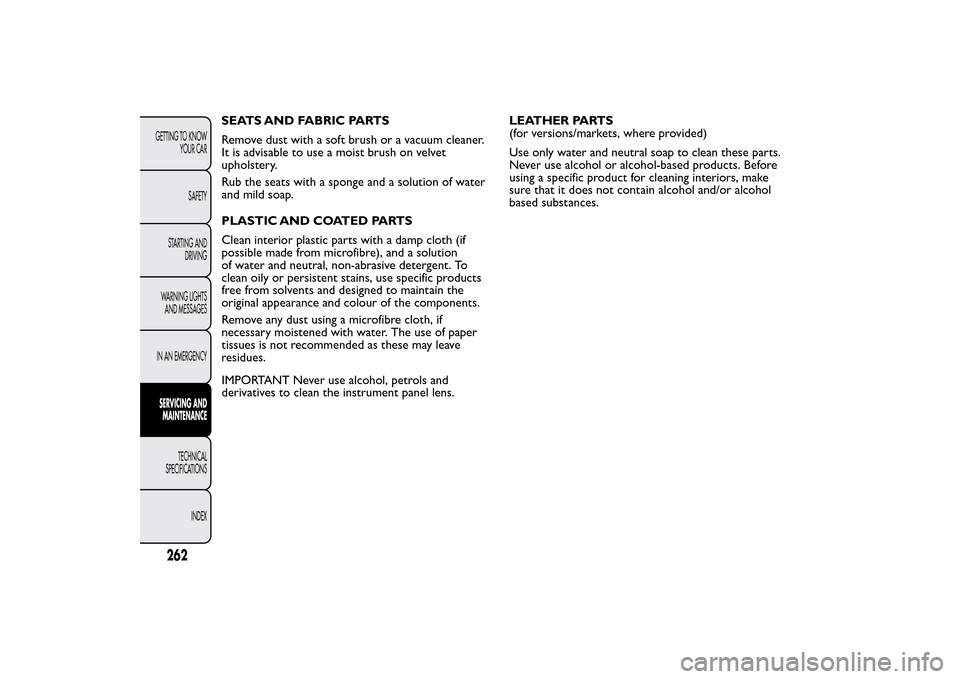
SEATS AND FABRIC PARTS
Remove dust with a soft brush or a vacuum cleaner.
It is advisable to use a moist brush on velvet
upholstery.
Rub the seats with a sponge and a solution of water
and mild soap.
PLASTIC AND COATED PARTS
Clean interior plastic parts with a damp cloth (if
possible made from microfibre), and a solution
of water and neutral, non-abrasive detergent. To
clean oily or persistent stains, use specific products
free from solvents and designed to maintain the
original appearance and colour of the components.
Remove any dust using a microfibre cloth, if
necessary moistened with water. The use of paper
tissues is not recommended as these may leave
residues.
IMPORTANT Never use alcohol, petrols and
derivatives to clean the instrument panel lens.LEATHER PARTS
(for versions/markets, where provided)
Use only water and neutral soap to clean these parts.
Never use alcohol or alcohol-based products. Before
using a specific product for cleaning interiors, make
sure that it does not contain alcohol and/or alcohol
based substances.
262GETTING TO KNOW
YOUR CAR
SAFETY
STARTING AND
DRIVING
WARNING LIGHTS
AND MESSAGES
IN AN EMERGENCYSERVICING AND
MAINTENANCE
TECHNICAL
SPECIFICATIONS
INDEX
Page 267 of 420
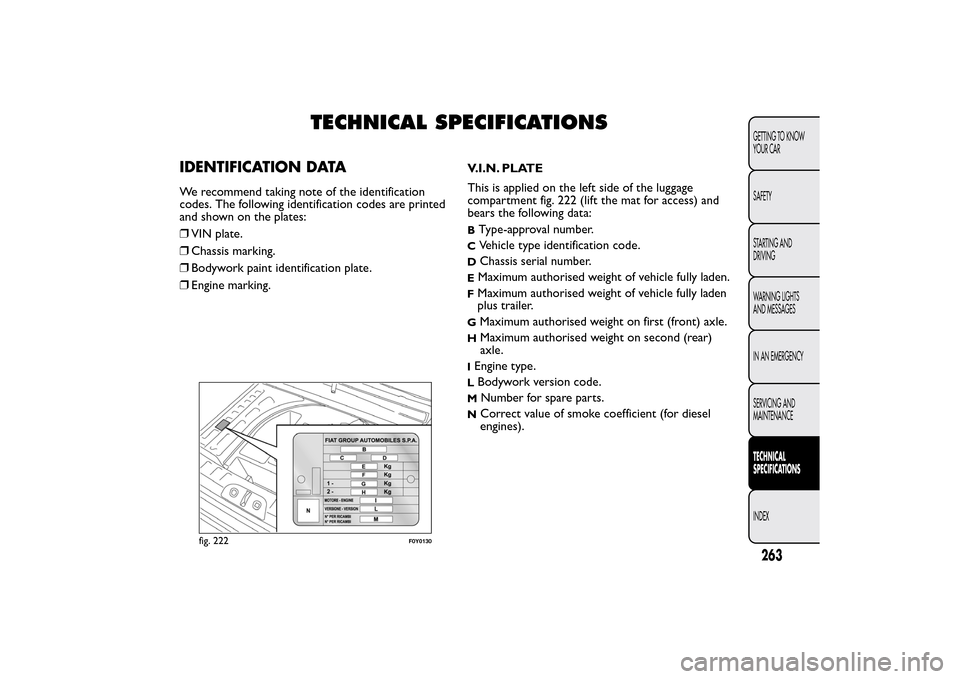
TECHNICAL SPECIFICATIONS
IDENTIFICATION DATAWe recommend taking note of the identification
codes. The following identification codes are printed
and shown on the plates:
❒VIN plate.
❒Chassis marking.
❒Bodywork paint identification plate.
❒Engine marking.V.I.N. PLATE
This is applied on the left side of the luggage
compartment fig. 222 (lift the mat for access) and
bears the following data:
BType-approval number.C
Vehicle type identification code.
D
Chassis serial number.
EMaximum authorised weight of vehicle fully laden.FMaximum authorised weight of vehicle fully laden
plus trailer.G
Maximum authorised weight on first (front) axle.
H
Maximum authorised weight on second (rear)
axle.
IEngine type.LBodywork version code.M
Number for spare parts.
N
Correct value of smoke coefficient (for diesel
engines).
fig. 222
F0Y0130
263GETTING TO KNOW
YOUR CAR
SAFETY
STARTING AND
DRIVING
WARNING LIGHTS
AND MESSAGES
IN AN EMERGENCY
SERVICING AND
MAINTENANCETECHNICAL
SPECIFICATIONSINDEX
Page 268 of 420
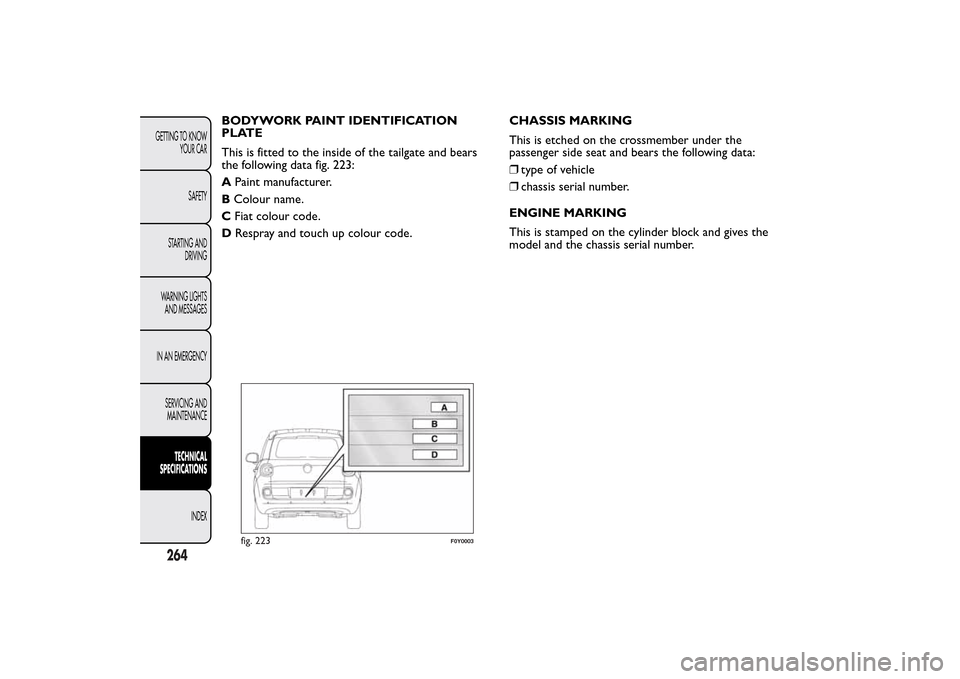
BODYWORK PAINT IDENTIFICATION
PLATE
This is fitted to the inside of the tailgate and bears
the following data fig. 223:
APaint manufacturer.
BColour name.
CFiat colour code.
DRespray and touch up colour code.CHASSIS MARKING
This is etched on the crossmember under the
passenger side seat and bears the following data:
❒type of vehicle
❒chassis serial number.
ENGINE MARKING
This is stamped on the cylinder block and gives the
model and the chassis serial number.
fig. 223
F0Y0003
264GETTING TO KNOW
YOUR CAR
SAFETY
STARTING AND
DRIVING
WARNING LIGHTS
AND MESSAGES
IN AN EMERGENCY
SERVICING AND
MAINTENANCE
TECHNICAL
SPECIFICATIONS
INDEX
Page 269 of 420
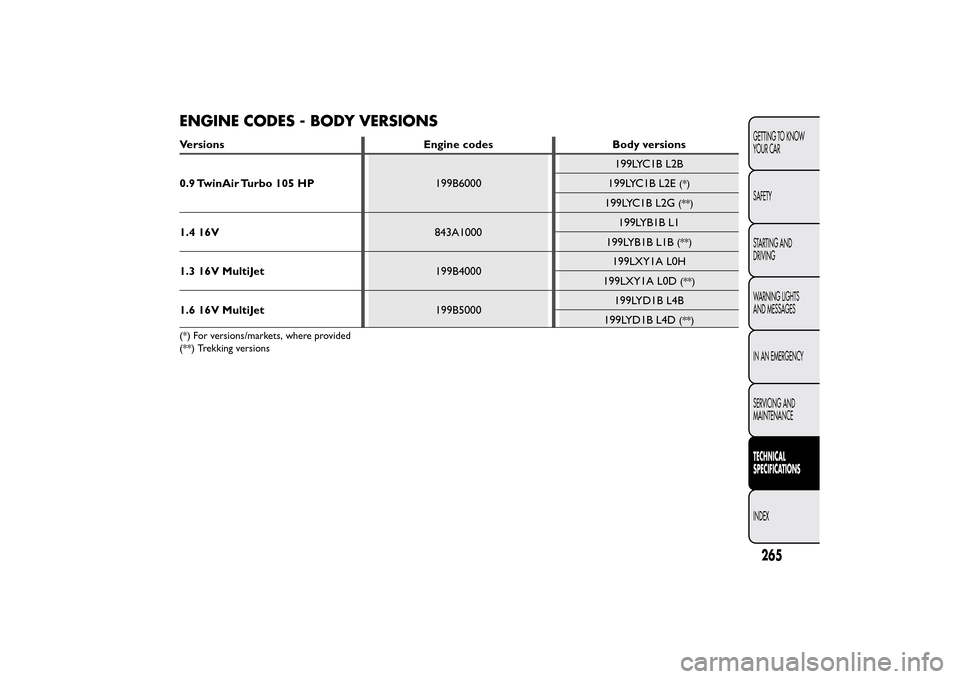
ENGINE CODES - BODY VERSIONSVersions Engine codes Body versions
0.9 TwinAir Turbo 105 HP199B6000199LYC1B L2B
199LYC1B L2E
(*)
199LYC1B L2G
(**)
1.4 16V843A1000199LYB1B L1
199LYB1B L1B
(**)
1.3 16V MultiJet199B4000199LXY1A L0H
199LXY1A L0D
(**)
1.6 16V MultiJet199B5000199LYD1B L4B
199LYD1B L4D
(**)
(*) For versions/markets, where provided
(**) Trekking versions
265GETTING TO KNOW
YOUR CAR
SAFETY
STARTING AND
DRIVING
WARNING LIGHTS
AND MESSAGES
IN AN EMERGENCY
SERVICING AND
MAINTENANCETECHNICAL
SPECIFICATIONSINDEX
Page 270 of 420
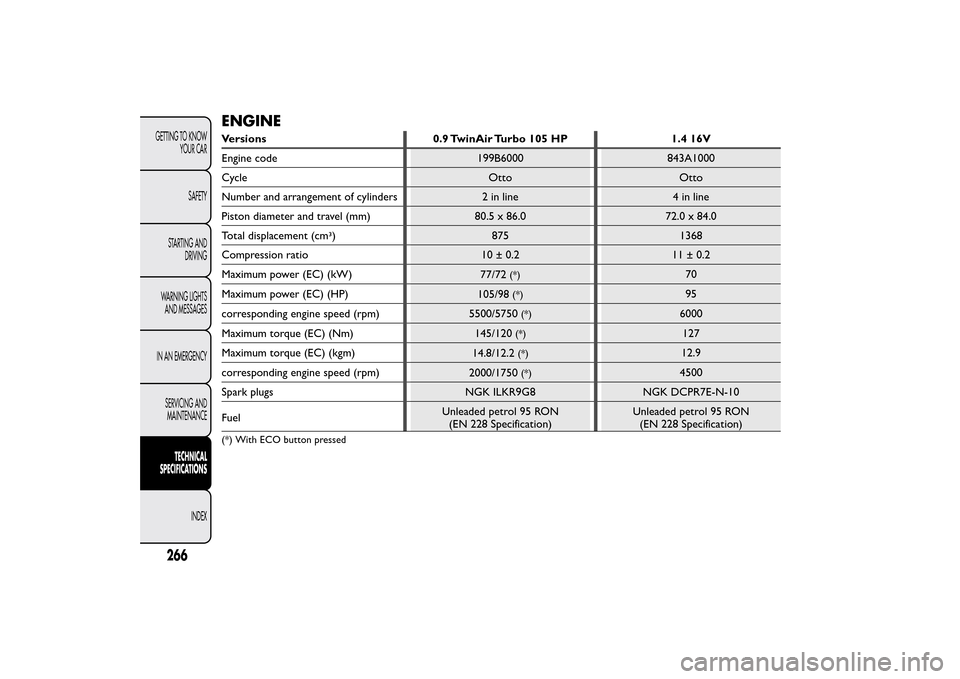
ENGINEVersions 0.9 TwinAir Turbo 105 HP 1.4 16V
Engine code 199B6000 843A1000
Cycle Otto Otto
Number and arrangement of cylinders 2 in line 4 in line
Piston diameter and travel (mm) 80.5 x 86.0 72.0 x 84.0
Total displacement (cm3) 875 1368
Compression ratio 10 ± 0.2 11 ± 0.2
Maximum power (EC) (kW)
77/72
(*)
70
Maximum power (EC) (HP)
105/98
(*)
95
corresponding engine speed (rpm)
5500/5750
(*)
6000
Maximum torque (EC) (Nm)
145/120
(*)
127
Maximum torque (EC) (kgm)
14.8/12.2
(*)
12.9
corresponding engine speed (rpm)
2000/1750
(*)
4500
Spark plugs NGK ILKR9G8 NGK DCPR7E-N-10
FuelUnleaded petrol 95 RON
(EN 228 Specification)Unleaded petrol 95 RON
(EN 228 Specification)
(*) With ECO button pressed
266GETTING TO KNOW
YOUR CAR
SAFETY
STARTING AND
DRIVING
WARNING LIGHTS
AND MESSAGES
IN AN EMERGENCY
SERVICING AND
MAINTENANCE
TECHNICAL
SPECIFICATIONS
INDEX